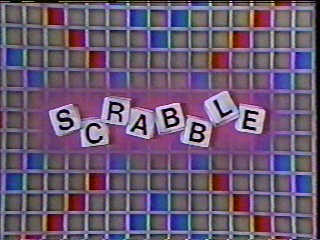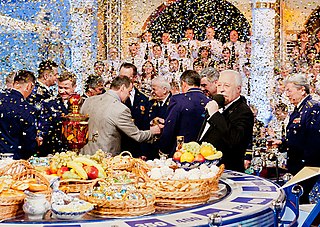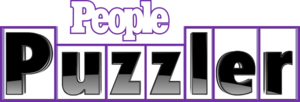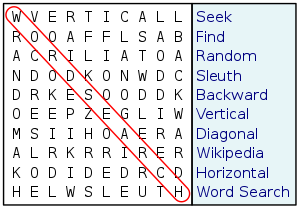
A crossword is a word game consisting of a grid of black and white squares, into which solvers enter words or phrases ("entries") crossing each other horizontally ("across") and vertically ("down") according to a set of clues. Each white square is typically filled with one letter, while the black squares are used to separate entries. The first white square in each entry is typically numbered to correspond to its clue.

A cryptic crossword is a crossword puzzle in which each clue is a word puzzle. Cryptic crosswords are particularly popular in the United Kingdom, where they originated, as well as Ireland, Israel, the Netherlands, and in several Commonwealth nations, including Australia, Canada, India, Kenya, Malta, New Zealand, and South Africa. Compilers of cryptic crosswords are commonly called "setters" in the UK and "constructors" in the US. Particularly in the UK, a distinction may be made between cryptics and "quick" crosswords, and sometimes two sets of clues are given for a single puzzle grid.

Boggle is a word game in which players try to find as many words as they can from a grid of lettered dice, within a set time limit. It was invented by Allan Turoff and originally distributed by Parker Brothers.

The Playfair cipher or Playfair square or Wheatstone–Playfair cipher is a manual symmetric encryption technique and was the first literal digram substitution cipher. The scheme was invented in 1854 by Charles Wheatstone, but bears the name of Lord Playfair for promoting its use.

Scrabble is an American television game show based upon the Scrabble board game. Muriel Green of Exposure Unlimited developed the idea for a television game show based upon the board game concept. During 1983, Green convinced Selchow and Righter, who at that time owned the Scrabble board game, to license Exposure Unlimited to produce the game show. Exposure Unlimited co-produced the show with Reg Grundy Productions, and licensed the show to NBC. Scrabble aired on NBC from July 2, 1984, to March 23, 1990, and again from January 18 to June 11, 1993. Chuck Woolery hosted the program. Jay Stewart was the announcer for the first year. Charlie Tuna replaced him in the summer of 1985 and remained through the original run and the entirety of the 1993 revival.
Arthur Wynne was the British-born inventor of the modern crossword puzzle.

Fill-Ins, also known as Fill-It-Ins or Word Fill-Ins, are a variation of the common crossword puzzle in which words, rather than clues, are given, and the solver must work out where to place them. Fill-Ins are common in puzzle magazines along with word searches, cryptograms, and other logic puzzles. Some people consider Fill-Ins to be an easier version of the crossword. Since the Fill-In requires no outside knowledge of specific subjects, one can solve the puzzle in another language.

A word square is a type of acrostic. It consists of a set of words written out in a square grid, such that the same words can be read both horizontally and vertically. The number of words, which is equal to the number of letters in each word, is known as the "order" of the square. For example, this is an order 5 square:

At The Carnival is a puzzle video game by Cliff Johnson published in 1989 by Miles Computing.
Games World of Puzzles is an American games and puzzle magazine. Originally the merger of two other puzzle magazines spun off from its parent publication Games magazine in the early 1990s, Games World of Puzzles was reunited with Games in October 2014.

Crosswords DS is a puzzle video game developed by American studio Nuevo Retro games released by Nintendo for the Nintendo DS handheld video game console. It was previously released in Australia as CrossworDS but a new OFLC entry confirmed that Nintendo Australia re-released it with a European localization. Crosswords DS features over 1,000 crossword puzzles that the player solves by using the stylus. Despite the title, it also features word search puzzles and anagram puzzles. It makes use of similar handwriting mechanics that the Brain Age titles make use of. Crosswords DS is included in the Touch! Generations series of titles, which includes such popular games as Brain Age: Train Your Brain in Minutes a Day! and Nintendogs. The background music was composed by Fabian Del Priore.
La Settimana Enigmistica is a weekly Italian word puzzle and word search magazine, published since 1932 with Europe-wide distribution. It's one of Italy's most popular and top-selling magazines. One of the footers on the front page of the magazine states è il settimanale che vanta innumerevoli tentativi di imitazione. Indeed, numerous other publications have followed in the wake of its popularity.
In the history of cryptography, a grille cipher was a technique for encrypting a plaintext by writing it onto a sheet of paper through a pierced sheet. The earliest known description is due to Jacopo Silvestri in 1526. His proposal was for a rectangular stencil allowing single letters, syllables, or words to be written, then later read, through its various apertures. The written fragments of the plaintext could be further disguised by filling the gaps between the fragments with anodyne words or letters. This variant is also an example of steganography, as are many of the grille ciphers.

Pole Chudes is a Soviet, later Russian adaptation of the U.S. game show Wheel of Fortune produced by VID, provided with elements of Russian culture and hosted by Leonid Yakubovich. The current rating of the show suggests it is intended for ages 16 and above, unlike the American version which is suitable for all age groups.
The New York Times crossword puzzle is a daily American-style crossword puzzle published in The New York Times as part of The New York Times Games, online on the newspaper's website, syndicated to more than 300 other newspapers and journals, and on mobile apps.
Wonderword is a word search puzzle, still created by hand, with a solution at the end. All the words in the grid connect and the remaining letters spell out the answer. The puzzles are either in a 15×15 or 20×20 grid. Each puzzle has a title, theme, solution number and wordlist.

Pazurgo is a word puzzle which normally takes the form of a rectangular grid with white and shaded squares. Pazurgo includes elements from Crossword puzzles and Word Search puzzles, along with the addition of its own unique elements.

Microsoft Ultimate Word Games is a word puzzle game published by Microsoft Studios, first released for Windows Phone as 'Wordament' on April 24, 2012. The game was relaunched in June 2017 with two new game modes, Crosswords and Word Twister.

A spiral puzzle is a word puzzle in the form of a spiral. The puzzle is formed of a long chain of letters, which spell out a list of clued words when read in either direction. The solutions to the left are entered in the boxes from 1 to 100. The responses to the right provide another set of words that must be entered from 100 to 1. The final solution can consist of a number of boxes, sometimes in colored horizontal, vertical or diagonal rows.

People Puzzler is an American television game show hosted by Leah Remini and broadcast by Game Show Network. It premiered on January 18, 2021. The show is inspired by the celebrity and pop-culture themed crosswords in People magazine.















